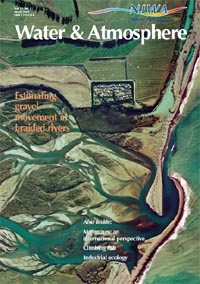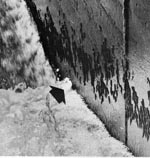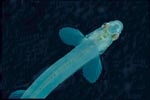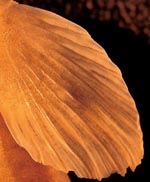PDF of this article (106 KB)

Bob McDowall
Specially adapted fins in the koaro may help to explain why this fish is so good at climbing.

The climbing ability of the koaro, Galaxias brevipinnis, has become legendary over recent decades. This fish species is highly migratory and spends its larval/juvenile life in the sea, yet populations have been found upstream of high waterfalls. We can only assume that fish must have climbed the falls to invade the streams above them.
From time to time, people have actually observed koaro climbing. For example, years ago, they were seen climbing the velocity barrier in the Wairehu Canal, North Island (where the population is landlocked). The canal system diverts water from the upper Wanganui River system eastwards into Lake Otomangakau, and from there into Lake Rotoaira, where it passes through the Tokaanu Power Station and eventually contributes to electricity generation in the series of lakes along the Waikato River, below Lake Taupo. The barrier was inserted in the Wairehu Canal to prevent fish from moving out of Lake Rotoaira. But the koaro were too smart, and at least some managed to scale the barrier walls as the photograph shows.
Many other situations have contributed to the climbing legend of the koaro – both natural waterfalls, and artificial barriers. Years ago, Nelson botanist Peter Williams phoned asking about fish feeding at the surface of Boulder Lake in the mountains behind Nelson. I told him they were almost certainly koaro. “Well, how did they get into the lake?” he asked, quite reasonably – and I can understand his scepticism, as Boulder Lake drains via a waterfall over 60 metres high. Well, I still think they probably climbed the waterfall to get into the lake.
Typically, when climbing, koaro leave the main flows, use surface tension on the wet rock to remain attached, and slither their way upwards with surprising ease. It’s well known among whitebaiters that koaro whitebait will climb up the side of buckets. Aquarists know, or soon find out, that koaro can easily scale the glass walls of an aquarium and, without a secure top on the aquarium, will turn up dehydrated and dead on the floor in the morning.
Koaro are not alone among fish in their climbing ability. Banded kokopo (Galaxias fasciatus) are no slouches when it comes to climbing and nor are shortjaw kokopu (G. postvectis). Other galaxiids are not bad either, but koaro are probably the best. For this reason the species is sometimes known in Australia as “climbing galaxias”.
Adapted to climb?
Part of the climbing skill of these galaxiids results from the way their pectoral and pelvic fins are oriented. Instead of sitting vertically behind the gill openings and functioning as paddles – as pectoral fins do in most fish – the pectoral fins of many galaxiids (including the koaro) face ventrally like rather broad, flat feet. The pelvic fins have a similar orientation. So despite the koaro’s scientific name – brevipinnis, which means short fins – the species actually has very large pectoral and pelvic fins. In Australia again, the fish is sometimes referred to as the “broadfin galaxias”. Thus, the paired fins in the koaro, added to their under-body surfaces, provide a quite substantial area that can assist the fish in using simple surface tension to remain attached to a wet, vertical rock surface. As long as turbulent flows or splashing do not dislodge the fish, koaro can climb to virtually any height. The fins probably also act as depressors when water is flowing over them, enhancing their ability to stay attached.
Special ridges help climbing ability


The downward-facing fins of the koaro are, however, only a part of the story. If you look carefully with a low-power microscope or small hand-lens at the underside of koaro pectoral and pelvic fins, you will find that they have evolved special adaptations for climbing. There are strong, backward-facing ridges on the front part of the fins that I strongly suspect play a significant role in the behaviour of these fish. Possibly the ridges adapt the fish for maintaining position in swift flows in the torrent habitats they often occupy. But the same ridges would also pre-adapt them for climbing.
Some biologists have real problems distinguishing koaro from Canterbury galaxias, G. vulgaris and other related species, and reckon that one way to tell a koaro is by the particular way it “walks” on your hand.
The photo shows a koaro whitebait taken when the fish was attached to a glass surface. If you look carefully, you can see distinct white lines running parallel to the fin rays in the right pectoral fin. The next photo shows the ventral surface of the pectoral fin of an adult koaro, and there the cause of the white lines in the first photograph can easily be seen. Callus-like ridges, with backward-facing, quite sharpened edges run parallel to the front three or four fin rays in the pectoral fin. These ridges even bifurcate (branch) in parallel to the bifurcations of the fin rays themselves. Similar ridges are present in the pelvic fins. One cannot help thinking that the ridges in the koaro are a key element in contributing to its climbing ability.
Similar ridges are present in other galaxiids known as climbers, including banded kokopu and shortjaw kokopu. Though not as strong, they are also evident in Canterbury galaxias G. vulgaris, flathead galaxias G. depressiceps, and some others of the G. vulgaris species group. Interestingly, the ridges are weak in roundhead galaxias G. anomalus and are absent from dwarf galaxias G. divergens, neither of which has a reputation for being a strong climber.
NB: the PDF of this article includes additional illustrations.
Teachers: this article can be used for Biology L7 A.O. 7.1b, and NCEA AS 2.6, and 3.4. See other curriculum connections at www.niwa.co.nz/pubs/wa/resources
Bob McDowall is based at NIWA in Christchurch.
